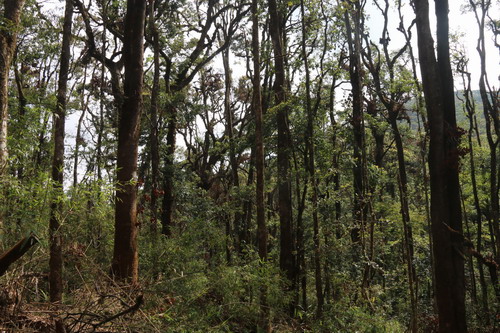
Decomposition of organic matter is an important component of material cycling in forest ecosystems. Previous studies have focused on the decay of dead plant material such as fine litterfall and coarse woody debris, but decomposition also occurs in living trees as hollows develop. The decomposition rate of tree hollows determines the speed of hollow formation. However, few studies have considered the rate of hollow formation in estimates of the forest carbon budget. Respiration of wood inside tree hollows is expected to differ from that of coarse woody debris.
Assoc. Prof. ZHENG Zheng and his colleagues of Xishuangbanna Tropical Botanical Garden (XTBG) conducted a study in a well preserved old-growth evergreen broad-leaved forest that consists primarily of species of Fagaceae, Theaceae, Lauraceae and Magnoliaceae in the Ailao Mountains National Nature Reserve, SW China. They hypothesized that the decomposition rate of decaying wood inside living tree hollows was substantial enough to influence the estimates of stem biomass, but it was lower than that of downed tree trunks and standing dead trees due to lower moisture content. Consequently, tree hollows required a long time to form.
To test the hypotheses, the researches measured respiration rates of wood inside tree hollows, logs(downed tree trunks) and snags (standing dead trees) using infrared CO2 analysis. They compared stem radial growth rates to the horizontal expansion rates of hollows. They also estimated the proportion of hollows to total stem volume and the time required to form nesting hollows.
The study found that the decomposition of wood inside living tree hollows was slow, only half that of downed tree trunks, due to their lower moisture content. Although wood decomposition in tree hollows was slow, it still caused the formation of large hollows or pipes in trunks. It took more than 50 years for large hollows to form, and animals dependent on large hollows can only nest in old-growth forests. However, the average radial (horizontal) expansion rate of tree hollows was almost similar to that of stem radial growth, and the vertical extension was 8 times faster than horizontal extension. Thus, hollow development could cause a considerable overestimate of biomass in old-growth forest. The researchers suggested that tree hollow development should be taken into account in future calculations of forest carbon stocks.
The study entitled “Hollows in living trees develop slowly but considerably influence the estimate of forest biomass” has been published online in Functional Ecology.

Old-growth evergreen broad-leaved forest in Ailao mountains (Image by LIU Qiang)
Contact:
ZHENG Zheng, Associate Professor
Key Laboratory of Tropical Forest Ecology, Xishuangbanna Tropical Botanical Garden, Chinese Academy of Sciences,
Mengla, Yunnan 666303, China
Tel: 86-871-65149746
Fax: 86-691-8715070
E-mail: zhengz@xtbg.ac.cn

86-10-68597521 (day)
86-10-68597289 (night)

52 Sanlihe Rd., Xicheng District,
Beijing, China (100864)

